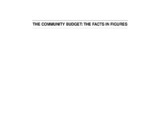| dc.description.abstract | Some important concepts5IntroductionThe Community’s public finances are governed by two type of instruments:— Positive law consists primarily of the financial provisions of the Treaties (Article 272 ofthe EC Treaty, Article 78 of the ECSC Treaty and Article 177 of the Euratom Treaty),which lay down the procedure for adopting and implementing each annual budget. Themain aspects are listed on page. It also covers the Decision of 21 April 1970 setting upthe own resources system (and subsequent amending Decisions), described in detail onpage 9. Finally, the detailed rules for implementing these provisions are set out in theFinancial; Regulation of 21 December 1977, as last amended on 17 December 1998.— There is also a large corpus of soft law in this field, recently consolidated in theInterinstitutional Agreement of 6 May 1999, which incorporates and supplements all theInterinstitutional Agreements, joint declarations and other agreements between theinstitutions involved in the budgetary debate (Parliament, Council and the Commission)and contains the financial framework for expenditure over the period 2000 to 2006 (see‘Agenda 2000’, page 103).The Community also has several financial instruments which, for avariety of reasons, arenot included in the general budget. Information on the ECSC operatingbudget and the EDFcan be found on pages 19 and 20 and in the tables 35 and 36; borrowing and lendingactivities can be found in Table 5.The history of the budget from its beginnings to the present day is contained in Part I which,in addition to general data on changes in revenue and expenditure (Tables 1 to 4), focuseson more specific data such as changes in the staffing levels of the institutions (Table 6) orthe development of borrowing and lending activities (Table 5). The period 1988 to 1992,which is closely linked to the implementation of the Single Act, heralds the modern era ofthe Community’s public finances marked by the emergence of a new concept - the “financialperspective”. This is the subject of Part II which draws a comparison between the budgetand the ceilings of the financial perspective. The intermediate period (1993 to 1998) isdivided into two separate parts: Part III presents the financial framework 1993 to 1999arising from the Interinstitutional Agreement of 29 October 1993 and Part IV gives adetailed description of the budget adopted for 1999. The last two parts deal with the mostrecent developments: Part V looks at Agenda 2000 and the financial framework for theperiod 2000-2006 and Part VI contains an exhaustive presentation of the preliminary draftbudget for 2001.A glossary at the end of the volume gives the meanings of the abbreviations and acronymsused and a bibliography proposes further publications for readers seeking more detailedinformation |

